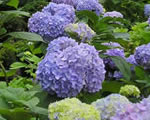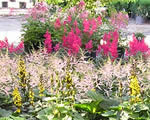
5155
NW 57th Ave
Johnston, Iowa
Click for Directions
Store
Hours
Monday
- Friday
8:00am - 5:00pm
Saturday
8:00am - 4:00pm
Hosta Propogation
| My hosta
clump is huge, can I divide it? Sure, but it is not necessary. Hostas
do not have to be divided. Many varieties of hostas look better
as they increase in size. Other perennials, like daylilies, should
be divided to keep them looking their best. This is a misconception
with hostas. However, there are plenty of good reasons to divide
a hosta.
A very common reason for dividing hostas is for propagation. The definition of propagation is to regenerate or reproduce. A gardener might want to use extra plants created through division in a mass planting, a border, or sharing with friends. Will dividing a hosta be harmful to the plant? No. Hostas can be divided anytime. It is best to divide in spring or fall when the plant is dormant, but summer division will not hurt the hosta. What is the best way for a residential gardener to divide a hosta? First, it is important to understand the structure of a hosta. The hosta clump is comprised of many small plants called divisions. Each of these divisions has its own root system. As a hosta ages, the number of divisions in the clump increases. Dividing a hosta is a process of separating the divisions. For large hostas, a clump diameter of at least 18 inches, the best way to divide the clump is to make cuts with a spade. It is easiest to do this while the plant is in the ground. The clump can be cut in half, quarters, or pie-shape pieces. The pieces can be planted like any other plant in the garden. The previously mentioned method is not always the best for very small clumps or prized selections. If special care is needed, it is best to dig out the entire clump and use a sharp knife to make the divisions. This allows for a much more accurate cut and careful division. Any gardener can learn to divide hostas, but there are exciting new methods of propagation available for mass production. Tissue-culture propagation is a process completed in a laboratory. This is done in a sterile lab setting where the plants being divided are so small they are first grown in a special design gel. The gel is comprised of all the nutrients the plant needs to grow. Combined with artificial light and controlled temperature, the hosta's growth can be closely monitored. As the hosta grows, it is transferred to a soiless mix. Tissue culture propagation has allowed new or rare varieties of hostas to be distributed much faster. Division from plants in the ground is a fairly slow process. Tissue culture propagation is much faster and thus increases the supply of rare varieties. This in turn lowers the price to the consumer. There are other forms of propagation including bud cutting, the Ross Method, and hormone-induced propagation. These methods are not as widely used. All of the hostas grown at Miller Nursery come from clump division or tissue-culture propagation. The hosta seems so simple, but the science behind the propagation is very exciting. |
© Miller Nursery Inc. 2008


